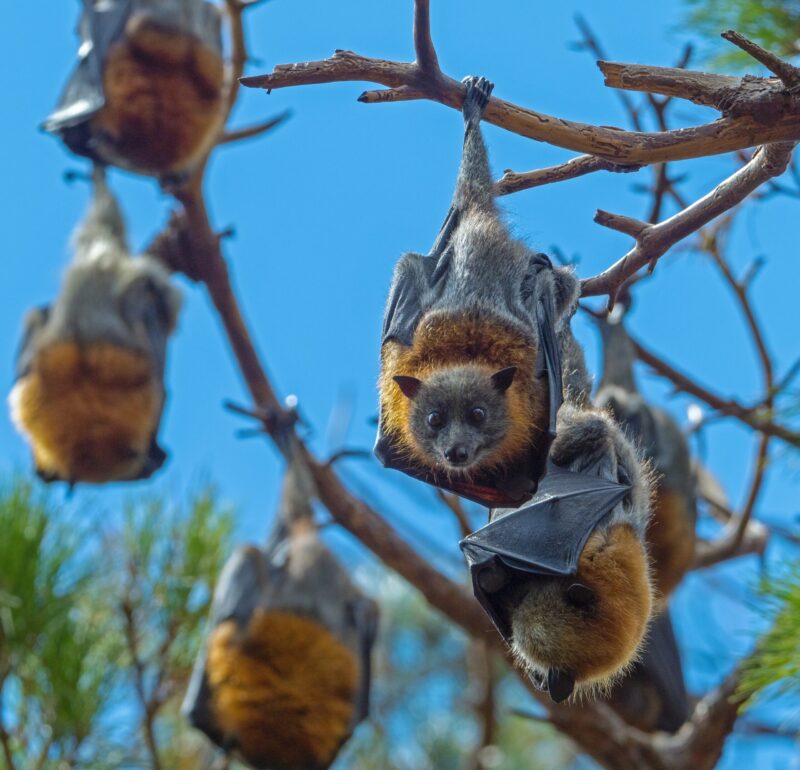What animal has pointy teeth, is more active at night, and sleeps hanging upside down? You guessed it! A bat.
What are bats?

Many people think of these little animals as dangerous bloodsuckers, like fictional vampires. But there are 1,400 species of bats in the world. Most eat insects, fruits and fish. Only three species of bats feed solely on blood. Not bat, I mean, not bad!
Most bats are small mammals, but there are surprisingly large species too. The largest is the flying fox or Pteropus. It’s a megabat ranging from 4 to 56 ounces (120 to 1,600 grams). Its wingspan is nearly 5 feet (1 1/2 meters).
The smallest is the Kitti’s hog-nosed bat (aka bumblebee bat). This species is about 1.1 to 1.3 inches (27 to 33 mm) in length, and 0.071 ounces (2 grams) in mass, making it the world’s smallest mammal. And speaking of insects, bats are incredible pollinators, too. While insects pollinate flowers during the day, our furry friends pollinate during the night.
If you like bananas, avocados and mangoes, thank a bat. And if you find mosquitoes annoying, well, bats are your best ally. Night insects have the most to fear from bats, as bats are extremely valuable in controlling insect pests. A common bat can eat over 3,000 bugs in just one night. Wow, bon appétit!
The 2024 lunar calendars are here! Best Christmas gifts in the universe! Check ’em out here.

Curious things about bats
Bats have many unique features. For instance, bats are the only mammals that can fly. Yes, we might be mammals ourselves, but we don’t count when traveling by planes or hot air balloons. No cheating!
A bat’s wing resembles a modified human hand. Imagine the skin between your fingers larger, thinner and stretched. This flexible skin membrane that extends between each long finger bone and many movable joints makes bats agile fliers. They are quite fast, too, as they can reach speeds over 100 miles per hour (160 km/h).
And, did you know? We have unique fingertips, and so do they! Well . . . the only difference is that their distinctive prints are in their wings.

Where do they live?
Bats can be found on nearly every part of the planet, except in extreme deserts and polar regions. Before daytime comes, they seek shelter to rest. Bats love caves because they have high ceilings where they can hang. But also, roofs keep them safe from many predators that hunt on the ground.

Some caves can have colonies of up to 20 million bats. But don’t worry. Baby bats won’t get lost among the crowd. Their wings are not the only thing that make them unique. Their voices and scents are also individual! This way, moms can easily find their babies. They have voice recognition, and what is even more impressive, they can navigate by echolocation. This means they can “see” using sounds.
Most bats hibernate, but some of them migrate to warmer areas in search for food.

Vampire bats
Like other mammals, mother bats feed their pups breastmilk, not insects. Most bats give birth to a single pup. Mama bats form nursery colonies in spring in caves, dead trees and rock crevices.
Only three species drink blood. But, no, their teeth are not like straws. What they do is bite another mammal, or sometimes birds, and then lick the blood with their tongues. But don’t worry about their victims, as bats don’t remove enough blood to harm them. Also, this little wound is so subtle that it can sometimes be undetected.

Bats are not only good in the dark sky, but it turns out that they are pretty good on the ground, too. Actually, that’s how vampire bats hunt. They move on the ground and then attack a warm spot to find their victims, with a kind of heat sensor on their noses.
And, did you know? They have anticoagulant in their saliva to help them with their liquid diet. So, they don’t kill their prey, but they can provoke nasty infections and diseases. If you ever find a bat, don’t touch it, as it can carry rabies. Bats are the leading cause of rabies deaths in the U.S.

Bat’s life
It’s said that the smaller the animal, the shorter its lifespan, but bats break that rule of longevity. Most bats live less than 20 years in the wild, but scientists have documented six species that can live more than 30 years. The longest-living bat was judged to be 41 years old; it was a tough old guy from Siberia.
Far from being dirty, bats spend a lot of time grooming themselves. Some even groom each other. They do this because cleaning helps control parasites.
Bats have few natural predators, like owls, hawks and snakes. What has killed millions of bats is the white-nose syndrome, named for a white fungus on the muzzle and wings of bats. This disease affects hibernating bats. Scientists are still working to understand the disease.

At least 12 types of U.S. bats are endangered, and more are threatened. These amazing animals face a multitude of threats including habitat loss and disease.
It’s a pity, as bats have inspired medical marvels. About 80 medicines come from plants that rely on bats for their survival. Also, by studying how bats use echolocation, scientists have developed navigational aids for blind people. Research on bats has also led to advances in vaccines. We could say that, like Batman, bats are the heroes of the night!
Bottom line: Bats might be spooky, but they pollinate flowers, control insect pests, and have inspired scientists around the world to improve human lives in many ways.











